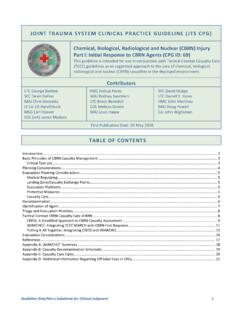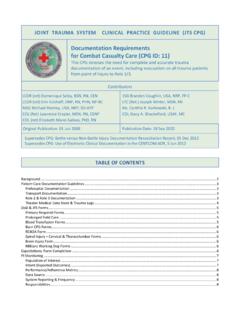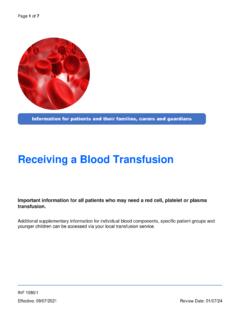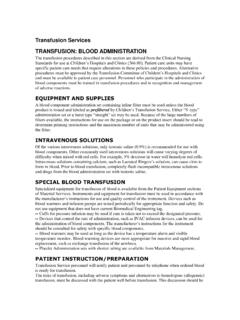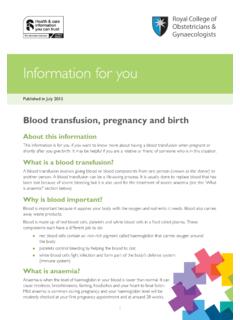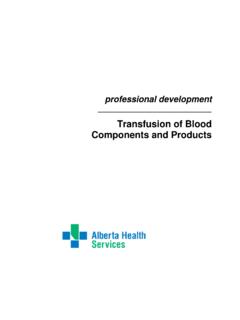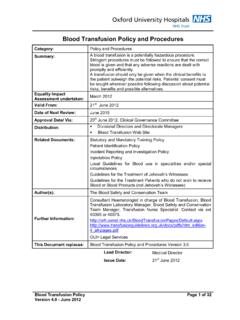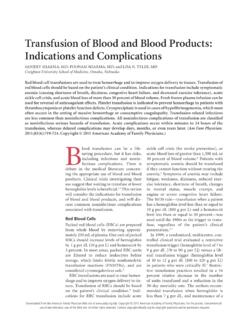Transcription of Whole Blood Transfusion (CPG ID: 21) - United States Army
1 JOINT TRAUMA SYSTEM CLINICAL PRACTICE GUIDELINE (JTS CPG). Whole Blood Transfusion (CPG ID: 21). This CPG provides the rationale and guidelines for WB Transfusion , including but not limited to product definitions, indications, collection, storage, testing, Transfusion , and documentation. Contributors COL Andrew P Cap, MC, USA COL Elon Glassberg, MC, IDF LTC Jose Quesada, MSC, USA. LTC Andrew Beckett, MC, CAF COL Jennifer Gurney, MC, USA COL Michael Reade, MC, ADF. MAJ Avi Benov, MC, IDF COL (ret) Richard Gonzales, MSC, USA MG Anne Sailliol, MC, France LTC Matthew Borgman, MC, USA COL Shawn F.
2 Kane, MC, USA PROF Philip C Spinella, US. PROF Barbara Bryant, MD, USA LTC (ret) Wilbur W Malloy, MSC, USA CAPT Zsolt Stockinger, MC, USN. LTC Jacob Chen, MC, IDF COL Shawn Nessen, MC, USA CDR Geir Strandenes, MC, Norway LTC Jason B Corley, MSC, USA COL Jeremy G Perkins MC, USA COL Audra Taylor, MSC, USA. COL (ret) Heidi Doughty, MC, UK MAJ Nicolas Prat, MC, France PROF Mark Yazer, MD, USA. MAJ Andrew Fisher, SP, USA. First Publication Date: 01 Oct 2006 Publication Date: 15 May 2018 Supersedes CPG dated 24 Oct 2012. TABLE OF CONTENTS. Definitions.
3 2. 3. Advantages of Whole Blood over Components .. 3. Considerations in Choosing SWB or FWB .. 4. Whole Blood Recommendations .. 5. Guidelines for Walking Blood Bank Program for FWB .. 5. WBB Planning .. 6. WB Pediatric Considerations .. 7. Performance Improvement (PI) Monitoring .. 8. Population of Interest .. 8. Intent (Expected Outcomes) .. 8. Performance/Adherence Metrics .. 8. Data Source .. 8. System Reporting & 8. References .. 8. Appendix A: Walking Blood Bank Process Map .. 11. Appendix B: Blood Donor Pre-screening SOP .. 12. Appendix C: Emergency Whole Blood Collection 21.
4 Appendix D: Additional Information Regarding Off-label Uses in CPGs .. 39. Guideline Only/Not a Substitute for Clinical Judgment 1. Whole Blood Transfusion CPG ID: 21. DEFINITIONS. Whole Blood (WB) collected in the anticoagulants CPD or CPDA-1 is an FDA-approved product when it is appropriately collected, stored and tested for Transfusion transmitted disease (TTD) by a licensed Blood donor center. It can be stored for 21 days at 1-6 C in CPD or 35 days at 1-6 C in CPDA-1 and is designated stored Whole Blood (SWB) in this CPG. SWB retains in vitro hemostatic parameters to an acceptable level during approved storage However, after the first 2 weeks of storage, the hemostatic function of WB may vary and supplementation with fresher Whole Blood units or Blood components, especially platelets, may be necessary.
5 Fresh Whole Blood (FWB) refers to WB collected on an emergency basis from a walking Blood bank (WBB). FWB can either be stored at room temperature and used within 24 hours of collection (and then destroyed if not used) or it can be refrigerated within 8 hours of collection, after which point it becomes WBB-SWB. FWB is considered to have full hemostatic function. FWB is collected from pre-screened donors when possible, but does not undergo TTD testing prior to Transfusion ; this fact makes it not approvable by the FDA. Because FWB. presents a higher risk of disease transmission, it is reserved for situations in which tested Blood products are unavailable or ineffective (further discussion below).
6 The most important safety consideration in transfusing WB is that donor red Blood cells (RBCs) be compatible with the recipient to avoid acute hemolytic Transfusion reactions ( , major mismatch). WB from group O. donors contains RBCs that are compatible with all recipients, but the plasma in group O WB may contain anti-A. and anti-B antibodies that could cause hemolysis in a non-group O recipient ( , minor mismatch). There are two approaches to mitigating this risk: 1) transfuse only group-specific WB ( A to A, B to B, AB to AB and O to O), or 2) anti-A and anti-B antibody titers can be measured in group O WB and only units containing a low titer of antibody ( , <1:256 saline dilution, immediate spin method) are designated low titer O WB (LTOWB) and these are used as universal WB.
7 LTOWB has been used extensively to resuscitate combat casualties and was a standard of care in WWII, and the conflicts in Korea and Note that LTOWB may be either SWB or may be collected from pre-screened O donors in a WBB protocol and thus be considered FWB ( , the Ranger O Low titer or ROLO protocol).3 In practice, the only SWB supplied by the Armed Services Blood Program (ASBP) to OCONUS locations will be LTOWB due to the relatively higher risk of donor-recipient Blood group mismatch and resulting hemolysis during group-specific WB Transfusion , compared to the much lower risk of hemolysis with Collecting LTOWB from WBB pre-screened donors is also preferred to group-specific Transfusion .
8 In short, most WB transfused during future contingency operations will be LTOWB, and most of this is likely to be SWB. Use of LTOWB is recognized under AABB Standard (31st Edition, AABB Standards, in effect beginning 01 April 2018).4. It should be noted that anti-A and anti-B titers may vary in group O donors. Ideally, WBB donors should be re- titered every 90 days in conjunction with TTD testing. However; since availability of titer testing in the deployed setting is very limited, every effort should be made to ensure that donors are titered at least annually if not prior to each deployment.
9 ASBP collects WB from male and never-pregnant female donors, or from female donors testing negative for anti-HLA antibodies (this mitigates risk of Transfusion -associated acute lung injury, TRALI). WB is primarily collected from Rh positive donors and there is a limited supply of Rh negative Blood products in the deployed environment. Every effort should be made to provide Rh negative Whole Blood or red cells to females of child-bearing potential (age<50 years) who are Rh negative or of unknown Blood type. However;. should transfusions of Rh positive Blood products occur in these patients, these must be thoroughly documented in the patient's medical record due to the risk of allo-immunization to Rh and potential for hemolytic disease of the fetus/newborn (HDFN) in future pregnancies.
10 All WB products (SWB, FWB, and LTOWB) are indicated for the resuscitation of massive Blood loss. WB, and in particular LTOWB, is the preferred resuscitation product for the pre-hospital treatment of patients in hemorrhagic ,6 This CPG will distinguish between stored Whole Blood (SWB) and fresh Whole Blood (FWB), and discuss uses and limitations of both products. Guideline Only/Not a Substitute for Clinical Judgment 2. Whole Blood Transfusion CPG ID: 21. BACKGROUND. The first documented animal-to-animal (dog) Blood Transfusion was performed at Oxford in 1665 by Richard Lower, followed by the first animal-to-human Blood Transfusion in 1667 by Jean Denis.


